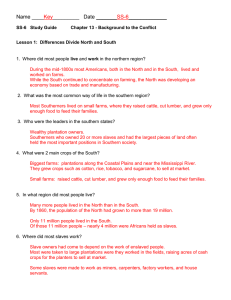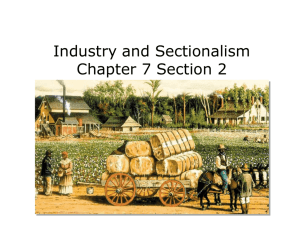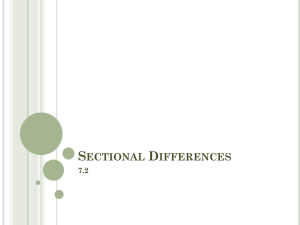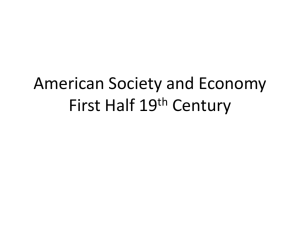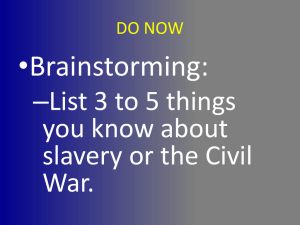Antebellum Review (11-12)
advertisement
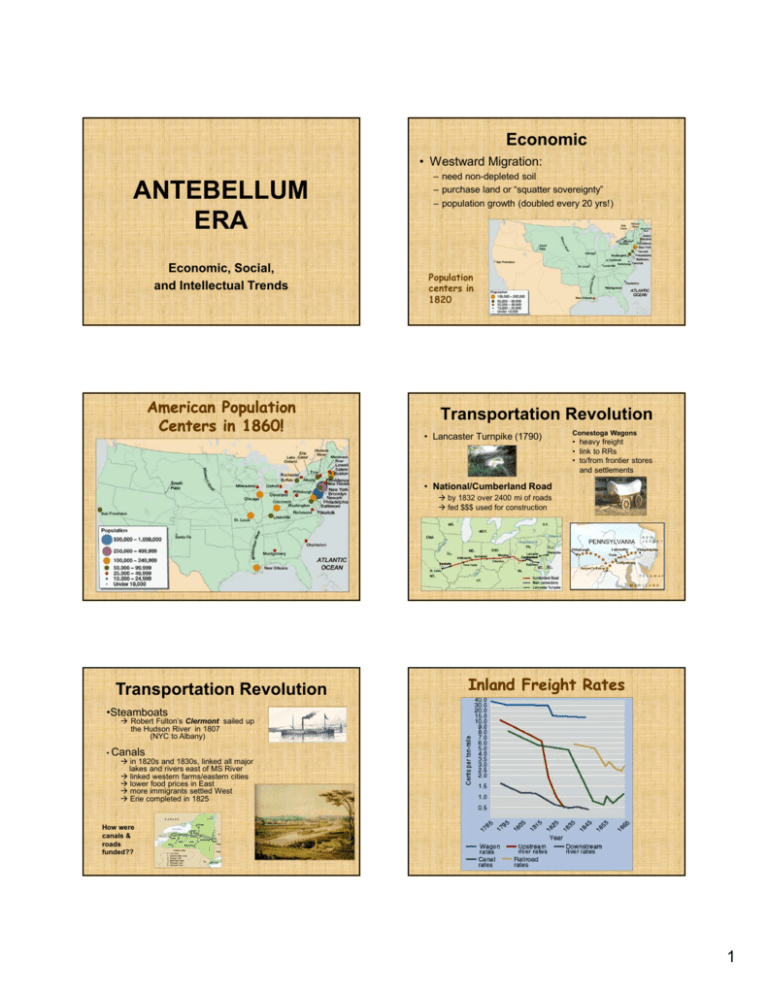
Economic • Westward Migration: ANTEBELLUM ERA Economic, Social, and Intellectual Trends American Population Centers in 1860! – need non-depleted soil – purchase land or “squatter sovereignty” – population growth (doubled every 20 yrs!) Population centers in 1820 Transportation Revolution • Lancaster Turnpike (1790) Conestoga Wagons • heavy freight • link to RRs • to/from frontier stores and settlements • National/Cumberland Road by 1832 over 2400 mi of roads fed $$$ used for construction Transportation Revolution Inland Freight Rates •Steamboats Robert Fulton’s Clermont sailed up the Hudson River in 1807 (NYC to Albany) • Canals in 1820s and 1830s, linked all major lakes and rivers east of MS River linked western farms/eastern cities lower food prices in East more immigrants settled West Erie completed in 1825 How were canals & roads funded?? 1 Transportation Revolution • Clipper Ships 400 miles/day high $$ cargo not practical for wide range of products • Railroads MOST reliable/rapid of all by 1830s, RR’s were competing with canals as an alternative method for carrying passengers/freight new cities become commercial centers (Detroit, Cincinnati, Chicago) immigrants built the northern RRs slaves built the southern RRs Inventors and Inventions 1. John Deere A. cotton gin (1793) 2. Cyrus Field B. interchangeable parts rifle 3. Elias Howe and Isaac C. “father of the factory system” Singer D. mechanical reaper (1831) 4. Cyrus McCormick E. sewing machine (1840s) 5. Samuel Morse F. steel plow (1837) 6. Samuel Slater G. telegraph (1840) H. transatlantic cable (1858) 7. Eli Whitney *** big RR era not until 1850s and beyond *** Early Industrialization • patents (legal protection) • corporations form raise capital by selling shared of stock Limited Liability Corps “Incorporated” 14th Amendment privileges • factory system end of “putting out” system encouraged growth of financial businesses (banking, insurance) • labor hard to find (lure of cheap land in West)! Lowell Mills young, farm middle class women housed in company dormitories child labor early unions (Commonwealth of MA v. Hunt) The “American Dream” Americans regarded material advance as the natural fruit of American republicanism and proof of the country’s virtue and promise. A German visitor in the 1840s, Friedrich List, observed: “Anything new is quickly introduced here, including all of the latest inventions. There is no clinging to old ways. The moment an American hears the word ‘invention,’ he pricks up his ears.” Creating a Business-Friendly Climate Supreme Court Rulings • Charles River Bridge (1835) • Dartmouth v. Woodward (1819) • Fletcher v. Peck (1810) • Gibbons v. Ogden (1824) • McCulloch v. Maryland (1819) A. upheld the sanctity of contracts (use twice) B. business competition (i.e., no monopolies) supports community interests C. BUS constitutional; states can’t regulate a federal institution D. only Congress may regulate interstate commerce Agricultural Economy • Commercial Agriculture farming more of commercial enterprise less subsistence for family: □ cheap land/easy credit □ new markets in eastern cities, not just down the OH & MS Rivers to southern markets • King Cotton cotton gin = higher profitability 2 Market Revolution Social Effects • women • definition dramatic changes (1800 to 1860) gave rise to new forms of social life, politics, etc. • economic impact NATIONALIZING the economy through regional inter-dependence independent, selfreliant, yeoman farmer/artisan/shop dependent on market forces (supply/demand) far beyond one’s control no longer worked with husbands on family farms jobs limited to domestic service or teaching largely only for single women (Lowell was the exception!) married women expected to be in domestic sphere still no legal rights yet fewer parental arranged marriages some had fewer children • slavery expanded along with cotton industry • social mobility • specialization farm, cities, industries adjusted production to certain products meant end of self-sufficient households growing interdependence of regions (esp. W and N) Sectionalism real wages improved gap between rich/poor WIDENED social mobility was generational economic opportunities still better than in Europe “The Industrial Juggernaut” • definition: loyalty to a particular region • Northeast and Old Northwest West North/East South • 1826 – 50th anniversary of independence big celebrations! proud of working/flexible Constitution • while strong nationalism, sectionalism persisted (BUS, tariffs, states’ rights, slavery) Industrial Northeast bound by transportation and economic growth based on commercial farming/industrialization manufacturing was expanding most still agriculture most populous region (high birthrate, immigration) Industrial Northeast • textile industry first to industrialize expand to other consumer goods, farming tech. • organized labor Commonwealth v. Hunt (1842) limited improvement for workers periodic depressions employers/courts generally hostile to unions abundant supply of cheap immigrant labor • urban life lots cities, but become crowded, disease, poor sanitation, crime in working-class neighborhoods still attracted lots from farms and Euro. immigrants • African-Americans small minority could have family, sometimes own land no economic/political equality denied access to early unions often hired as strikebreakers 3 Agricultural Northwest Immigration: Changes North push factors • linked to rest of North cheap/faster transport famines revolutions canals and railroads military campaigns against Indians pull factors econ. opp’s need for unskilled workers 1820-1860 • impact of agricultural changes: steel plow, mechanical reaper mostly family farms few seasonal hired hands appealed to immigrants with $$$ Irish Catholic competed with AfricanAmericans for jobs joined Dem’s (anti-British) • new cities in “Northwest” Cincinnati Chicago Nativist Backlash German more $/skills move to NW territory big supporters of public education anti-slavery Changing Occupation Distributions St. Patrick's Day as the police attack the Irish with swords and batons. Know-Nothing Party of the 1850s “Defenders” of the public school system being attacked by members of the Roman Catholic church. South • those areas which permitted slavery included “border states” • tobacco, rice, & sugarcane …and KING COTTON • constantly needed new land When would this become the majority? Slavery in the South • “peculiar institution” (apologists’ euphemism) • wealth measured in land and slaves • fear of revolts “positive Denmark Vesey’s plot (SC) good” ??? Nat Turner’s Rebellion (VA) led to slave codes restricted no more talk of gradual emancipation following Turner’s Rebellion inspired hope for many African-Americans demonstrate evils of slavery to some in North • free blacks (~ 250,000) 4 Southern Whites Southern Ideology • elite wealthy planters (“slavocracy”) dominated state legislatures & made favorable laws very small portion of southern population, had most slaves • farmers • code of chivalry • education majority of slaveholders worked in the fields WITH slaves & lived modestly upper class valued college education not available to lower class slaves restricted from literacy after revolts • poor whites ~75% of southern population subsistence farmers; hillbillies hoped to one day own slaves • religion • mountain people: tiny portion of southern pop (Ozark & Appalachian Mtns.) Methodists and Baptists preached Biblical support for slavery, so gained members no Unitarians few Catholics disliked planters & slaves remained loyal to Union during Civil War • cities few cities (AGRICLTURE!!!!); key for trade but still small Charleston, Atlanta, Richmond, Chattanooga West • beyond MS River, to CA & OR Country • Natives relocation to Great Plains horses (brought by Columbian Exch.) change to nomadic from villages helped avoid settlers “Frontier” • concept persisted despite changing location fresh start and opportunity • “mountain men” • short life expectancy • women: isolation, work, short lifespan • environmental damage (animal pop., poor farming) Second Great Awakening Sectional Divisions • • Daniel Webster (MA) • John C Calhoun (SC) • Henry Clay (KY) the “giants of the Senate” • • • • • causes: new religious fervor challenged traditional Puritanism, Deism, growing secularism and Unitarianism circuit riders like Peter Cartwright led revivals Methodist and Baptist camp meetings Charles Finney in Burned Over District inspired many secular reform movements temperance abolition public education utopian socialism appealed to women encouraged to become missionaries and members of laity would become active in women’s rights movement 5 Religious Communal Experiments • Shakers celibacy and sex segregation common property high quality work/designs • Oneidas believed in perfectionism –’bible communism’ group marriage/ communal child-rearing econ. Equality/communal property • Mormons Book of Mormon violence against est. New Zion at Salt Lake distinctly American faith most successful/enduring Secular Utopia Reform Movements • education longer school year better salaries/training modernized curriculum expansion of higher ed. • New Harmony est. by Robert Owen utopian socialism absolute equality of all finanical problems and internal disputes brought end temperance Maine Law TS Arthur’s Ten Nights in a Barroom • mental illness/prison reform • legal system reduce death penalty crimes abandon flogging/cruelties lessen public hangings Reform Movements • American Colonization Society (Liberia) • abolitionism Quakers Grimkes Garrison Liberty Party • • Transcendentalism questioned established churches and capitalism self-reliance and spirituality (Emerson) conservation and civil disobedience (Thoreau) Brook Farm (MA) community intellectual and manual labor included many intellectuals of time women origins in abolition movement against Cult of Domesticity Lyon Culture • lyceums Stone Stanton traveling lecture programs adult education and self-improvement Willard Mott 6 Culture Culture • patriotic themes (1830s/1840s) • painting Crossing the Delaware The Landing of the Pilgrims – Hudson River School landscapes/beauty of America - Gilbert Stuart (portraits) - John Audubon • frontier themes noble savage ‘lasts’ and ‘dyings’ Stanley Hawk Barred Owl Culture • architecture – neoclassical style popular during Jacksonian era – glorify democratic spirit of republic • literature Jefferson Rotunda U. VA – distinctively American form began to emerge – hero was the “self-made man” 7

